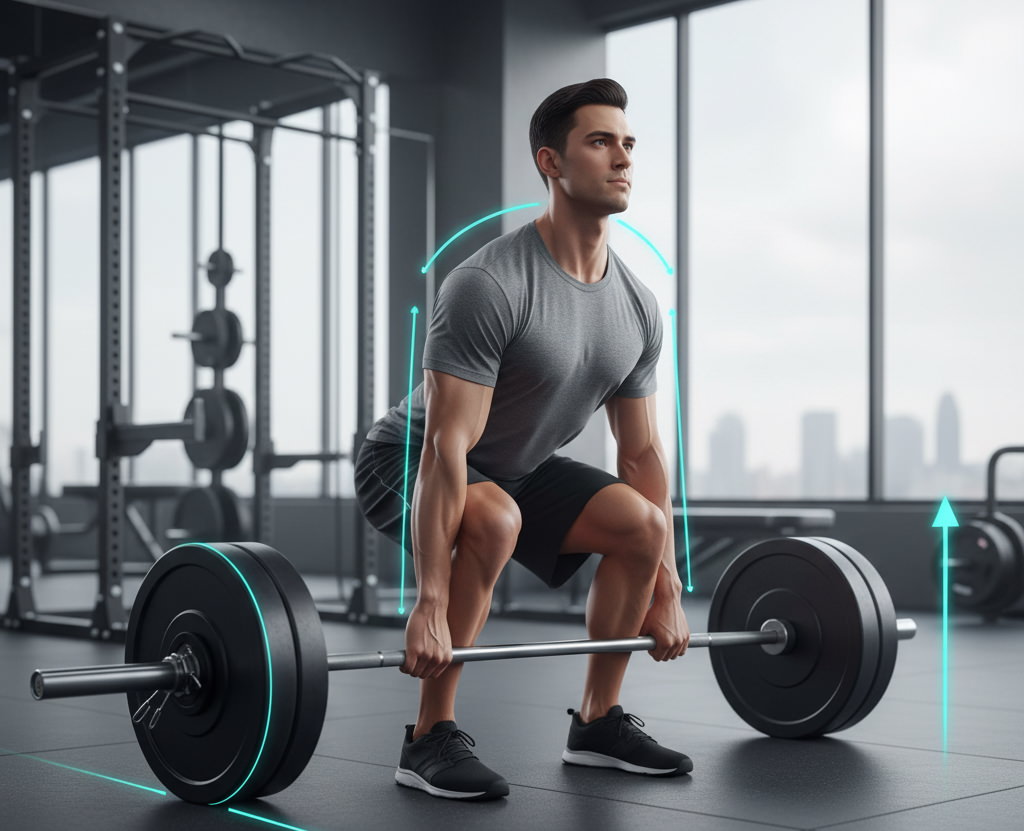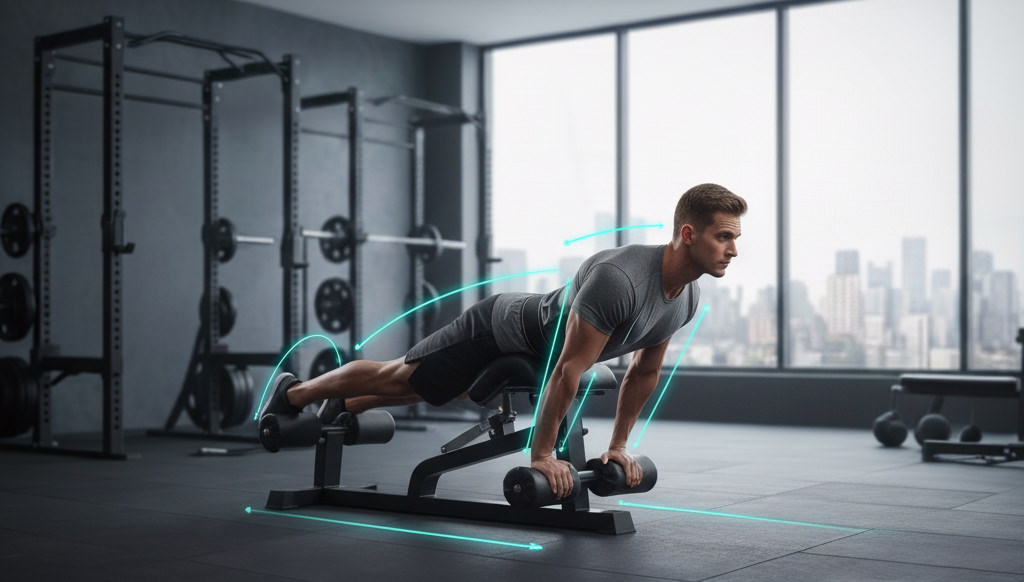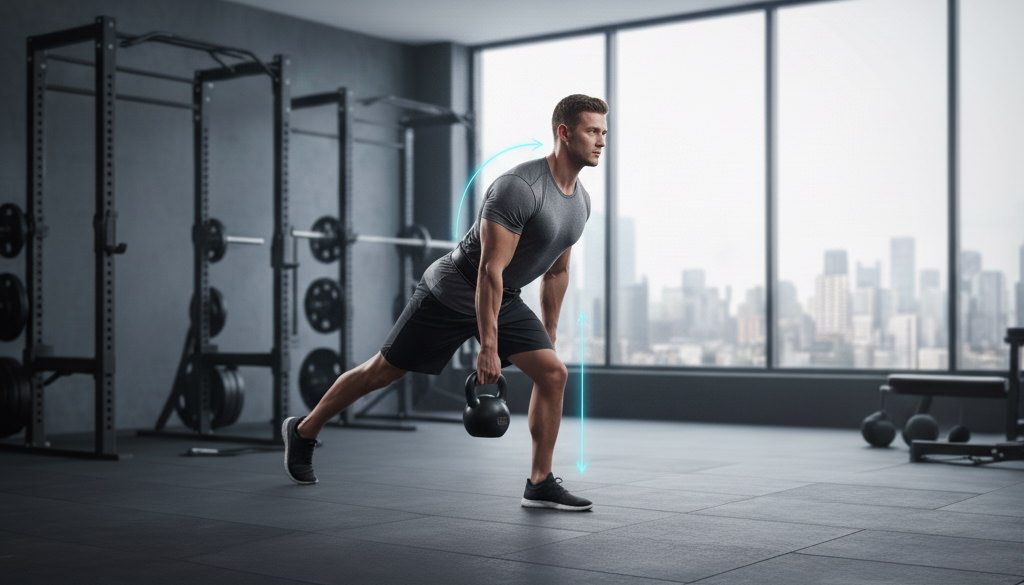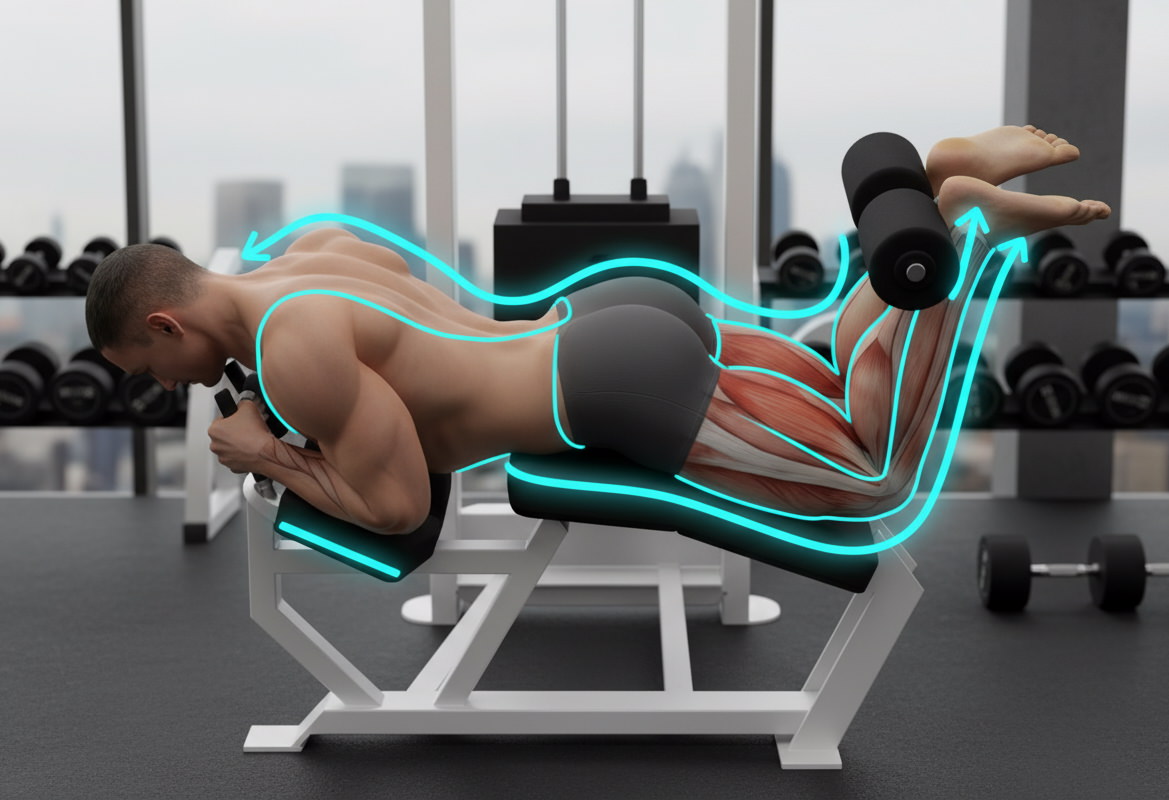Your hamstrings are the unsung heroes of athletic performance. These powerful muscles on the back of your thighs drive explosive movements—sprinting, jumping, lifting—and yet they're often overlooked in training programs. That's a costly mistake.
Strong hamstrings deliver:
- ✅ Explosive power for sprinting and jumping
- ✅ Injury prevention (hamstring strains are common)
- ✅ Better squat and deadlift performance
- ✅ Improved athletic performance across all sports
- ✅ Balanced leg development (not just quads)
Studies show that eccentric hamstring exercises can reduce injury risk by up to 60%, while research published in the Journal of Strength and Conditioning Research found that Romanian deadlifts and glute-ham raises produce the highest hamstring muscle activation.
This guide breaks down the 10 most effective hamstring exercises backed by science and endorsed by strength coaches. Whether you're an athlete, bodybuilder, or fitness enthusiast, these moves will transform your posterior chain.
QUICK REFERENCE: HAMSTRING EXERCISE RANKINGS
| Rank | Exercise | Difficulty | Equipment | Best For |
| 🥇 1 | Romanian Deadlift | Intermediate | Barbell/Dumbbells | Overall Development |
| 🥈 2 | Nordic Hamstring Curl | Advanced | Partner/Band | Injury Prevention |
| 🥉 3 | Barbell Deadlift | Intermediate | Barbell | Total Strength |
| 4 | Glute-Ham Raise | Advanced | GHD Machine | Eccentric Strength |
| 5 | Single-Leg RDL | Intermediate | Dumbbell/Kettlebell | Balance & Stability |
| 6 | Lying Leg Curl | Beginner | Leg Curl Machine | Isolation |
| 7 | Kettlebell Swing | Beginner | Kettlebell | Power & Conditioning |
| 8 | Barbell Hip Thrust | Intermediate | Barbell/Bench | Hip Extension |
| 9 | Good Morning | Intermediate | Barbell | Hip Hinge Pattern |
| 10 | Bulgarian Split Squat | Intermediate | Dumbbells | Unilateral Strength |
WHY HAMSTRING TRAINING MATTERS
The Athletic Performance Connection
Your hamstrings aren't just “leg muscles”—they're performance multipliers:
1. Explosive Power Generation The hamstrings drive hip extension, the primary movement in sprinting, jumping, and Olympic lifts. Research shows that hamstring strength correlates directly with sprint speed and vertical jump height.
2. Injury Prevention Hamstring strains are among the most common sports injuries. The British Journal of Sports Medicine reports that targeted hamstring strengthening reduces injury risk by 51%.
3. Compound Lift Performance Strong hamstrings improve your:
- Deadlifts (pulling power)
- Squats (knee stability, hip drive)
- Olympic lifts (explosive hip extension)
4. Knee and ACL Protection The hamstrings act as antagonists to the quadriceps, protecting the ACL from excessive strain. This is crucial for athletes in cutting sports (soccer, basketball, tennis).
HAMSTRING ANATOMY 101
Understanding your hamstrings helps you train them effectively.
The Three Hamstring Muscles:
1. Biceps Femoris (Outer Hamstring)
- Two heads: Long head and short head
- Function: Knee flexion, hip extension, external leg rotation
- Location: Outer back thigh
2. Semitendinosus (Middle Hamstring)
- Function: Knee flexion, hip extension, internal leg rotation
- Location: Middle back thigh
3. Semimembranosus (Inner Hamstring)
- Function: Knee flexion, hip extension, internal leg rotation
- Location: Inner back thigh
Key Functions:
✅ Hip Extension – Straightening at the hip (deadlifts, sprinting)
✅ Knee Flexion – Bending the knee (leg curls)
✅ Deceleration – Slowing down during running (eccentric control)
Training Implication: You need exercises that target BOTH hip extension and knee flexion for complete hamstring development.
THE 10 BEST HAMSTRING EXERCISES
🥇 1. ROMANIAN DEADLIFT (RDL)

Why It's #1: The RDL is the gold standard for hamstring development. EMG studies show it produces 70-80% maximum hamstring activation while also targeting glutes and lower back.
Muscle Activation:
- 🎯 Hamstrings: 85%
- 🎯 Glutes: 75%
- 🎯 Lower Back: 60%
How to Perform:
Setup:
- Stand with feet hip-width apart, holding a barbell at thigh level with an overhand grip
- Keep a slight bend in the knees (soft knees, not locked)
- Shoulders back, chest up, core braced
Execution:
- Push hips back (think: closing a car door with your butt)
- Lower the bar close to your shins, keeping back flat
- Descend until you feel a strong stretch in hamstrings (usually mid-shin)
- Drive hips forward to return to standing, squeezing glutes at top
Sets & Reps: 3-4 sets of 6-10 reps
Pro Tips:
✅ Bar stays close to legs throughout (scrape your shins)
✅ Think “pushing floor away” on the way up
✅ Don't round your lower back—maintain neutral spine
❌ Common mistake: Turning this into a squat (keep knees relatively fixed)
Variations:
- Dumbbell RDL – Easier on grip, better for beginners
- Single-Leg RDL – Unilateral strength, balance challenge
- Deficit RDL – Stand on plates for greater range of motion
🥈 2. NORDIC HAMSTRING CURL

Why It's Elite: The Nordic curl is the #1 exercise for hamstring injury prevention. Research shows it can reduce hamstring strain risk by up to 51% in athletes.
Muscle Activation:
- 🎯 Hamstrings: 90% (eccentric emphasis)
- 🎯 Glutes: 30%
- 🎯 Core: 40%
How to Perform:
Setup:
- Kneel on a pad with ankles secured (have a partner hold them, or use a loaded barbell)
- Body should form a straight line from knees to head
- Hands positioned in front, ready to catch yourself
Execution:
- Slowly lower your torso toward the ground, resisting with hamstrings
- Keep body rigid (plank position) – no hip bending
- Fight gravity for 3-5 seconds on the descent
- Use hands to push back up (assisted), or pull yourself back with hamstrings
Sets & Reps: 3 sets of 4-8 reps (it's HARD)
Pro Tips:
✅ Focus on eccentric (lowering) phase – that's where the magic happens
✅ Control the descent – don't freefall
✅ If too hard: Use resistance band for assistance
✅ If too easy: Add weight vest or go slower
Why Eccentrics Matter:
The American Journal of Sports Medicine found that eccentric hamstring strength is the #1 predictor of injury risk. Nordic curls specifically train this weakness.
🥉 3. BARBELL DEADLIFT

Why It's Essential: The king of compound movements. Deadlifts build total body strength while heavily recruiting hamstrings during hip extension.
Muscle Activation:
- 🎯 Hamstrings: 70%
- 🎯 Glutes: 85%
- 🎯 Lower Back: 80%
- 🎯 Traps: 60%
How to Perform:
Setup:
- Feet hip-width apart, bar over midfoot
- Grip bar just outside legs (overhand or mixed grip)
- Hips higher than knees, shoulders over bar
- Chest up, back flat, core braced
Execution:
- Pull slack out of the bar (create tension)
- Drive through floor with legs while standing up
- Keep bar close to body throughout lift
- Full hip extension at top (stand tall, don't hyperextend)
- Control descent by pushing hips back
Sets & Reps: 3-5 sets of 3-6 reps (go heavy)
Pro Tips:
✅ “Leg press the floor” on the way up
✅ Maintain neutral spine (no rounding or hyperextending)
✅ Bar path should be vertical (straight up and down)
❌ Don't pull with your back – legs and hips do the work
Deadlift Variations:
- Sumo Deadlift – Wider stance, more quad/glute emphasis
- Trap Bar Deadlift – More quad-dominant, easier on lower back
- Deficit Deadlift – Increased range of motion
4. GLUTE-HAM RAISE (GHR)

Why It's Powerful: The GHR is one of the few exercises that trains BOTH hamstring functions simultaneously (hip extension AND knee flexion).
Muscle Activation:
- 🎯 Hamstrings: 95% (highest activation)
- 🎯 Glutes: 70%
- 🎯 Calves: 40%
How to Perform:
Setup:
- Position yourself on GHD machine with feet secured
- Knees on pad, thighs perpendicular to floor
- Body forms 90-degree angle
Execution:
- Start with torso upright, knees bent
- Slowly lower torso to parallel with floor
- Straighten knees as you lower (hamstrings lengthening)
- Pull yourself back up using hamstrings (curl motion + hip extension)
Sets & Reps: 3 sets of 6-10 reps
Pro Tips:
✅ Most effective hamstring exercise per EMG data
✅ If too hard: Use band assistance or reduce range
✅ If no GHD: Substitute Nordic curls
❌ Don't use momentum – slow and controlled
Research Spotlight: The Journal of Strength and Conditioning Research found GHRs produce 30% higher hamstring activation than lying leg curls.
5. SINGLE-LEG ROMANIAN DEADLIFT

Why It Works: Unilateral training fixes strength imbalances while improving balance and stabilization. Plus, it heavily targets hamstrings.
Muscle Activation:
- 🎯 Hamstrings: 80%
- 🎯 Glutes: 75%
- 🎯 Gluteus Medius: 65% (hip stabilizer)
- 🎯 Core: 50%
How to Perform:
Setup:
- Stand on one leg, holding dumbbell or kettlebell in opposite hand
- Slight bend in standing knee
- Free leg extended behind you
Execution:
- Hinge at hip, pushing free leg back
- Lower weight toward standing foot
- Keep back flat, hips square to ground
- Lower until strong hamstring stretch (parallel to ground)
- Drive through standing heel to return to standing
Sets & Reps: 3 sets of 8-12 reps per leg
Pro Tips:
✅ Focus on balance – this is as much about stability as strength
✅ Keep hips square (don't let them rotate)
✅ Squeeze glute on standing leg at top
❌ Don't round your back to go lower – maintain form
Athletic Benefits:
Single-leg work directly translates to running mechanics and sports performance where you're often on one leg.
6. LYING LEG CURL

Why It's Valuable: Pure hamstring isolation. No compensation from other muscle groups means maximum hamstring focus.
Muscle Activation:
- 🎯 Hamstrings: 75% (pure knee flexion)
- 🎯 Calves: 20%
How to Perform:
Setup:
- Lie face-down on leg curl machine
- Adjust pad so it sits just above heels
- Grip handles, press hips into pad
Execution:
- Curl weight toward glutes by bending knees
- Squeeze hamstrings at peak contraction (1-2 second hold)
- Slowly lower for 2-3 seconds (eccentric focus)
- Don't let weight stack touch between reps (constant tension)
Sets & Reps: 3-4 sets of 10-15 reps
Pro Tips:
✅ Eccentric matters – take 2-3 seconds to lower
✅ Keep hips pressed down (don't let them lift)
✅ Full range of motion – stretch and contract completely
✅ Point toes toward shins for extra calf engagement
Volume & Hypertrophy:
For muscle growth, aim for higher reps (12-20) with moderate weight and 30-60 seconds rest.
7. KETTLEBELL SWING
Why It's Dynamic: The swing trains explosive hip extension—the same movement pattern as sprinting and jumping. It's also great for conditioning.
Muscle Activation:
- 🎯 Hamstrings: 65%
- 🎯 Glutes: 80%
- 🎯 Lower Back: 50%
- 🎯 Core: 60%
How to Perform:
Setup:
- Stand with feet slightly wider than hip-width
- Kettlebell 12-18 inches in front of you
- Hinge to grab bell with both hands
Execution:
- Hike bell back between legs (like hiking a football)
- Explosively thrust hips forward, standing tall
- Bell swings to chest/eye level (arms stay straight)
- Let gravity pull bell back down
- Receive bell with hip hinge, load hamstrings
- Immediately explode into next rep
Sets & Reps: 3-5 sets of 15-20 reps
Pro Tips:
✅ Hip hinge, not squat – this is a hamstring/glute move
✅ Power comes from hip snap, not arms
✅ Keep core braced throughout
✅ Stand tall at top – full hip extension
❌ Don't round lower back at bottom
Athletic Carryover:
The explosive hip extension pattern directly translates to sprinting mechanics and jumping ability.
8. BARBELL HIP THRUST
Why It's Effective: While known as a glute exercise, hip thrusts also heavily recruit hamstrings through hip extension, especially with feet positioned forward.
Muscle Activation:
- 🎯 Glutes: 95% (highest glute activation of any exercise)
- 🎯 Hamstrings: 60%
- 🎯 Quads: 25%
How to Perform:
Setup:
- Sit on ground, upper back against bench
- Barbell across hips (use pad for comfort)
- Feet flat, shoulder-width apart, knees bent 90 degrees
Execution:
- Drive through heels, lifting hips toward ceiling
- Squeeze glutes hard at top (full hip extension)
- Body forms straight line from shoulders to knees
- Hold peak contraction for 1-2 seconds
- Lower with control
Sets & Reps: 3-4 sets of 8-12 reps
Pro Tips:
✅ For more hamstring: Position feet 6-12 inches farther forward
✅ Tuck chin slightly (don't hyperextend neck)
✅ Full hip extension – don't stop short
✅ Squeeze glutes, don't just extend back
Loading Strategy:
Hip thrusts can be loaded HEAVY. Work up to 1.5-2x bodyweight for serious strength gains.
9. GOOD MORNING
Why It's Underrated: Good mornings teach proper hip hinge mechanics while building posterior chain strength and isometric core stability.
Muscle Activation:
- 🎯 Hamstrings: 70%
- 🎯 Lower Back: 75%
- 🎯 Glutes: 60%
- 🎯 Core: 70%
How to Perform:
Setup:
- Bar across upper back (like back squat position)
- Feet hip-width apart
- Slight knee bend maintained throughout
Execution:
- Hinge at hips, pushing butt back
- Lower torso to parallel (or until hamstring stretch)
- Keep back flat, chest up
- Drive hips forward to return to standing
Sets & Reps: 3 sets of 8-12 reps
Pro Tips:
✅ Start light – this exercise exposes weaknesses
✅ Maintain neutral spine (don't round or hyperextend)
✅ Keep shins vertical (minimal knee movement)
✅ Brace core hard throughout
❌ Don't go too heavy – form breaks down quickly
Coaching Cue:
Imagine a string attached to your tailbone pulling you backward.
10. BULGARIAN SPLIT SQUAT
Why It's Included: While primarily a quad exercise, the Bulgarian split squat hammers the hamstrings when performed with a forward lean and hip-dominant pattern.
Muscle Activation:
- 🎯 Quads: 85%
- 🎯 Hamstrings: 55%
- 🎯 Glutes: 75%
- 🎯 Core: 60%
How to Perform:
Setup:
- Rear foot elevated on bench (12-24 inches high)
- Front foot 2-3 feet from bench
- Dumbbells at sides or barbell on back
Execution:
- Lower down by bending both knees
- Front knee tracks over toes (slight forward lean)
- Descend until back knee nearly touches ground
- Drive through front heel to stand
- Keep torso upright to slightly forward
Sets & Reps: 3 sets of 8-12 reps per leg
Pro Tips:
✅ For more hamstring: Lean torso forward 10-15 degrees
✅ Front shin should stay relatively vertical
✅ Drive through heel, not toes
✅ Don't let front knee cave inward
Unilateral Benefits:
Addresses left-right strength imbalances and improves single-leg stability for sports.
HOW TO BUILD A HAMSTRING WORKOUT
Sample Workouts by Goal:
STRENGTH FOCUS (3-5 Reps)
- Barbell Deadlift: 4×5 (heavy)
- Romanian Deadlift: 3×6
- Glute-Ham Raise: 3×6-8
- Nordic Curl: 3×4-6
Rest: 2-3 minutes between sets
Frequency: 2x per week
HYPERTROPHY FOCUS (8-12 Reps)
- Romanian Deadlift: 4×8-10
- Lying Leg Curl: 3×12-15
- Single-Leg RDL: 3×10 per leg
- Hip Thrust: 3×12
- Bulgarian Split Squat: 3×10 per leg
Rest: 60-90 seconds
Frequency: 2-3x per week
ATHLETIC PERFORMANCE (Power + Strength)
- Kettlebell Swing: 4×15 (explosive)
- Barbell Deadlift: 4×5
- Nordic Curl: 3×6
- Single-Leg RDL: 3×8 per leg
Rest: 2-3 minutes (compound), 60-90 sec (accessories)
Frequency: 2x per week
INJURY PREVENTION (Eccentric Focus)
- Nordic Hamstring Curl: 3×5-8
- Glute-Ham Raise: 3×8
- Single-Leg RDL: 3×10 (slow eccentric)
- Lying Leg Curl: 3×12 (3-second lowering)
Rest: 90 seconds
Frequency: 2-3x per week
Training Principles:
1. Balance Your Training Include BOTH:
- ✅ Hip-dominant movements (RDLs, deadlifts)
- ✅ Knee-dominant movements (leg curls, nordics)
2. Emphasize Eccentrics Hamstrings are most vulnerable during eccentric (lengthening) contractions. Spend 2-3 seconds on the lowering phase.
3. Train 2-3x Per Week Hamstrings recover relatively quickly. Training frequency of 2-3x per week produces optimal results.
4. Progressive Overload Gradually increase:
- Weight (most common)
- Reps (within a rep range)
- Sets (weekly volume)
- Time under tension (slower tempo)
HAMSTRING INJURY PREVENTION
Common Hamstring Injuries:
1. Hamstring Strain (Most Common)
- Cause: Explosive movement with insufficient strength or warm-up
- Location: Usually proximal hamstring (near glute) or biceps femoris
- Recovery: 2-12 weeks depending on severity
2. Tendinopathy
- Cause: Overuse, repetitive strain
- Location: Hamstring tendons near knee or hip
- Recovery: 6-12 weeks with proper rehab
Prevention Strategies:
✅ 1. Nordic Curls Are Non-Negotiable
Multiple studies confirm: Nordic curls reduce hamstring injury risk by 51%. Do them 2x per week.
✅ 2. Warm Up Properly
Dynamic stretches + activation:
- Leg swings (10 each leg)
- Walking lunges (10 reps)
- Glute bridges (15 reps)
- Light RDLs (2×10)
✅ 3. Don't Skip Eccentrics
Hamstrings fail during the lengthening phase. Train that specific weakness with:
- Nordic curls
- Eccentric leg curls (3-5 second lowering)
- Eccentric RDLs
✅ 4. Address Muscle Imbalances
Hamstring-to-quad ratio should be at least 0.6:1 (ideally 0.7:1 or higher). If your hamstrings are significantly weaker than quads, injury risk increases.
Test: Can you leg curl at least 60% of what you leg extension? If not, prioritize hamstring work.
✅ 5. Gradually Progress Sprinting
Most hamstring injuries occur during high-speed running. Build sprint volume progressively:
- Week 1-2: 60-70% max speed
- Week 3-4: 70-80%
- Week 5+: 80-95%
HAMSTRING FLEXIBILITY & MOBILITY
Why It Matters:
Tight hamstrings contribute to:
- ❌ Lower back pain
- ❌ Poor squat depth
- ❌ Limited hip hinge ability
- ❌ Increased injury risk
Best Hamstring Stretches:
1. Standing Hamstring Stretch
- Foot on elevated surface (18-24 inches)
- Hinge at hips, reach toward toes
- Keep back flat (don't round)
- Hold 30-60 seconds per leg
2. Lying Hamstring Stretch with Strap
- Lie on back, loop strap around one foot
- Straighten leg toward ceiling
- Pull gently with strap for deeper stretch
- Hold 30-60 seconds per leg
3. Dynamic Leg Swings
- Hold wall or post for balance
- Swing leg forward and back (10-15 reps)
- Gradually increase range of motion
- Do before workouts
4. 90/90 Hamstring Stretch
- Lie on back, one leg at 90 degrees against wall
- Other leg straight on ground
- Hold 60-90 seconds
- Advance by scooting closer to wall
Stretching Guidelines:
Before Workout: Dynamic stretches (leg swings, walking lunges)
After Workout: Static stretches (hold 30-60 seconds)
Frequency: Daily if tight, 3-4x per week for maintenance
Important: Don't stretch cold muscles. Do light cardio first.
COMMON HAMSTRING TRAINING MISTAKES
❌ Mistake #1: Neglecting Eccentrics
The Problem: Most people only focus on the “lifting” phase.
Why It Matters: Hamstring injuries occur during eccentric (lengthening) contractions.
The Fix: Include Nordic curls and emphasize 2-3 second eccentric phases.
❌ Mistake #2: Only Training Knee Flexion
The Problem: Doing leg curls only.
Why It Matters: Hamstrings also extend the hip. Single-function training leaves you incomplete.
The Fix: Include hip extension exercises (RDLs, deadlifts, hip thrusts).
❌ Mistake #3: Using Too Much Weight
The Problem: Ego lifting with poor form.
Why It Matters: Hamstrings are injury-prone. Bad form = high risk.
The Fix: Master form with lighter weight first. Progress gradually.
❌ Mistake #4: Insufficient Volume
The Problem: One set of leg curls at the end of leg day.
Why It Matters: Hamstrings are large muscles that need adequate volume.
The Fix: Aim for 10-20 sets per week across 2-3 sessions.
❌ Mistake #5: Ignoring Unilateral Work
The Problem: Only bilateral (two-leg) exercises.
Why It Matters: Strength imbalances increase injury risk and limit performance.
The Fix: Include single-leg RDLs and Bulgarian split squats.
HAMSTRING TRAINING FAQ
Q: How often should I train hamstrings?
A: 2-3 times per week.
Hamstrings recover relatively quickly. Training them 2-3x per week optimizes strength and hypertrophy without overtraining.
Sample split:
- Monday: Heavy (deadlifts, RDLs)
- Thursday: Volume (leg curls, single-leg work)
- Saturday: Eccentrics (Nordic curls, GHRs)
Q: What's better: RDLs or deadlifts for hamstrings?
A: RDLs are slightly better for hamstring isolation.
While deadlifts involve more total muscle mass and build overall strength, RDLs keep constant tension on hamstrings throughout the movement.
Best approach: Include both.
- Deadlifts for total strength
- RDLs for targeted hamstring development
Q: Can I build hamstrings without weights?
A: Yes, but it's harder.
Bodyweight options:
- Nordic hamstring curls (most effective)
- Single-leg glute bridges
- Sliders hamstring curls
- Reverse hyperextensions
However, progressive overload is easier with weights. Eventually, you'll need external resistance.
Q: Why are my hamstrings always tight?
A: Likely weakness, not just tightness.
Tight hamstrings often indicate:
- Weakness – Your body creates tension as a protective mechanism
- Overuse – Too much volume without recovery
- Poor posture – Anterior pelvic tilt
Solution:
- Strengthen hamstrings (especially eccentrics)
- Stretch regularly (static after workouts)
- Address posture issues
Q: How long to see hamstring growth?
A: 6-12 weeks with consistent training.
Timeline:
- Weeks 1-4: Neural adaptations (strength gains)
- Weeks 4-8: Visible muscle growth begins
- Weeks 8-12: Noticeable size increase
- 6+ months: Significant development
Keys: Progressive overload, adequate volume (10-20 sets/week), and sufficient protein (0.7-1g per lb bodyweight).
Q: Should I train hamstrings on leg day or separate day?
A: Either works, but separate may be better for serious development.
Option 1: Leg Day (Most Common)
- Pros: Time-efficient, hamstrings already warm
- Cons: Fatigue from squats may limit hamstring work
Option 2: Separate Day (Advanced)
- Pros: Fresh energy for hamstrings, more volume possible
- Cons: Requires extra training day
Recommendation: Start with leg day inclusion. If hamstrings are lagging, add a separate session.
Q: Are leg curls enough for hamstrings?
A: No. You need hip extension work too.
Leg curls only train knee flexion. Your hamstrings also extend the hip (deadlifts, RDLs, hip thrusts).
Complete program includes:
- Hip extension exercises (RDLs, deadlifts)
- Knee flexion exercises (leg curls)
- Eccentric work (Nordic curls)
SCIENCE-BACKED HAMSTRING TRAINING TIPS
Tip #1: Prioritize Eccentrics
Research: American Journal of Sports Medicine found eccentric hamstring strength is the #1 predictor of injury risk.
Application: Include Nordic curls 2x per week and use 3-second eccentric phases on leg curls.
Tip #2: Train Through Full Range of Motion
Research: Full ROM produces 40% greater muscle growth than partial ROM.
Application:
- RDLs: Lower until strong hamstring stretch
- Leg curls: Full flexion and extension
- Don't cheat range to use heavier weight
Tip #3: Don't Fear Heavy Loading
Research: Heavy loads (80-90% 1RM) produce greater strength gains than light loads.
Application:
- Deadlifts: Work up to 3-6 reps at 80-85% 1RM
- RDLs: 6-8 reps at 75-80% 1RM
- Balance with higher-rep accessory work
Tip #4: Volume Matters for Growth
Research: Journal of Sports Sciences found 10-20 sets per week optimal for hypertrophy.
Application: Split volume across 2-3 sessions:
- Session 1: 6-8 sets
- Session 2: 4-6 sets
- Session 3 (optional): 4-6 sets
Tip #5: Recovery Is Non-Negotiable
Research: Hamstring injuries spike when recovery is inadequate.
Application:
- 48 hours minimum between hamstring sessions
- Sleep 7-9 hours per night
- Consume 0.7-1g protein per lb bodyweight daily
- Manage training stress (don't max out every session)
SAMPLE 4-WEEK HAMSTRING PROGRAM
Week 1-2: Foundation Phase
Day 1 (Monday):
- Romanian Deadlift: 4×8 @70% 1RM
- Lying Leg Curl: 3×12
- Single-Leg RDL: 3×10 per leg
- Nordic Curl (assisted): 3×5
Day 2 (Thursday):
- Barbell Deadlift: 4×6 @75% 1RM
- Glute-Ham Raise (assisted): 3×8
- Kettlebell Swing: 3×15
- Bulgarian Split Squat: 3×10 per leg
Week 3-4: Intensification Phase
Day 1 (Monday):
- Romanian Deadlift: 4×6 @75-80% 1RM
- Lying Leg Curl: 4×10 (3-sec eccentric)
- Single-Leg RDL: 3×8 per leg (heavier)
- Nordic Curl: 3×6-8
Day 2 (Thursday):
- Barbell Deadlift: 5×5 @80% 1RM
- Glute-Ham Raise: 3×8-10
- Hip Thrust: 4×10
- Good Morning: 3×8
Optional Day 3 (Saturday – Eccentric Focus):
- Nordic Curl: 4×6
- Eccentric Leg Curl: 3×8 (5-sec lowering)
- Glute Bridge Walk-out: 3×10
TRACKING PROGRESS
What to Measure:
1. Strength Metrics:
- RDL: Track weight for 8 reps
- Deadlift: Track 5RM
- Leg Curl: Track weight for 10 reps
- Nordic Curls: Track max reps
2. Volume Metrics:
- Total weekly sets for hamstrings
- Total tonnage (sets × reps × weight)
3. Visual & Functional:
- Take progress photos (side view)
- Measure hamstring girth
- Sprint times (if applicable)
- Vertical jump height
4. Injury Metrics:
- Hamstring tightness (subjective scale 1-10)
- Soreness duration
- Injury occurrences
Progressive Overload Strategies:
Option 1: Add Weight
- Increase load by 2.5-5 lbs when you hit top of rep range
Option 2: Add Reps
- Work from 8 → 12 reps before adding weight
Option 3: Add Sets
- Progress from 3 → 4 sets over 4-week block
Option 4: Improve Tempo
- Slow eccentric from 2 seconds → 4 seconds
Option 5: Reduce Rest
- Decrease rest periods from 90 → 60 seconds
NUTRITION FOR HAMSTRING DEVELOPMENT
Macronutrient Targets:
Protein: 0.7-1.0g per lb bodyweight
- Supports muscle protein synthesis
- Aids recovery
- Sources: Chicken, beef, fish, eggs, Greek yogurt, protein powder
Carbohydrates: 2-3g per lb bodyweight (active individuals)
- Fuels intense training
- Aids recovery
- Sources: Rice, oats, potatoes, fruits
Fats: 0.3-0.5g per lb bodyweight
- Hormone production
- Joint health
- Sources: Avocados, nuts, olive oil, fatty fish
Timing Considerations:
Pre-Workout (1-2 hours before):
- 30-40g carbs + 20g protein
- Example: Oatmeal with protein powder
Post-Workout (within 2 hours):
- 40-50g carbs + 30-40g protein
- Example: Chicken with rice and vegetables
Daily:
- Spread protein across 4-5 meals
- 20-40g protein per meal optimizes muscle protein synthesis
Supplements Worth Considering:
1. Creatine Monohydrate ✅
- Dose: 5g daily
- Benefit: Increased strength, power, muscle growth
- Evidence: Strong (1000+ studies)
2. Protein Powder ✅
- Dose: As needed to hit protein target
- Benefit: Convenient protein source
- Evidence: Strong
3. Beta-Alanine ⚠️
- Dose: 3-6g daily
- Benefit: Improved muscular endurance
- Evidence: Moderate (helpful for higher-rep work)
4. Caffeine ⚠️
- Dose: 3-6mg per kg bodyweight
- Benefit: Increased power output, focus
- Evidence: Strong (acute performance enhancement)
Skip: Most “testosterone boosters” and exotic supplements. Stick to proven basics.
ADVANCED TRAINING TECHNIQUES
1. Drop Sets (Leg Curls)
Perform a set to failure, immediately reduce weight by 20-30%, continue to failure.
Example:
- Set 1: 100 lbs × 10 reps (failure)
- Drop to 70 lbs × 6-8 reps (failure)
Benefit: Increases metabolic stress, muscle growth
2. Tempo Training
Manipulate lifting speed to increase time under tension.
Example RDL:
- 3-second lowering
- 1-second pause at bottom
- 1-second lifting
- (3-1-1-0 tempo)
Benefit: Greater muscle damage and growth stimulus
3. Isometric Holds
Hold at point of maximum tension.
Example Nordic Curl:
- Lower to 45-degree angle
- Hold for 10-20 seconds
- Repeat for 3-4 sets
Benefit: Builds strength at specific angles
4. Cluster Sets (Deadlifts)
Perform 1-2 reps, rest 15-20 seconds, repeat for 5-6 mini-sets.
Example:
- 2 reps @ 85% 1RM
- Rest 20 seconds
- Repeat 5 times (10 total reps)
Benefit: Accumulate heavy volume without excessive fatigue
5. Pre-Exhaust (RDLs + Leg Curls)
Fatigue hamstrings with isolation, then hit compound.
Example:
- Lying leg curl: 15 reps
- Immediately: Romanian deadlift: 8 reps
- Rest 90 seconds, repeat
Benefit: Ensures hamstrings are limiting factor in compound moves
CONCLUSION: BUILD BULLETPROOF HAMSTRINGS
Strong hamstrings aren't optional—they're essential for athletic performance, injury prevention, and balanced leg development.
Key Takeaways:
✅ Include BOTH hip extension and knee flexion exercises
✅ Prioritize eccentric training (Nordic curls = injury prevention gold)
✅ Train 2-3x per week with 10-20 sets total volume
✅ Progressive overload is non-negotiable
✅ Don't neglect flexibility work
Your Next Steps:
- Choose 4-5 exercises from this list
- Create a program using the sample templates
- Track your lifts weekly
- Be consistent for 8-12 weeks minimum
- Adjust based on results
Strong hamstrings will transform your:
- Squat and deadlift numbers
- Sprint speed and jumping ability
- Injury resilience
- Overall leg aesthetics
Now stop reading and go train those hammies. 💪
ADDITIONAL RESOURCES
Recommended Reading:
- “Starting Strength” by Mark Rippetoe
- “Science and Development of Muscle Hypertrophy” by Brad Schoenfeld
- “The Muscle and Strength Pyramid: Training” by Eric Helms
Helpful Videos:
- Alan Thrall (form tutorials)
- Jeff Nippard (science-based training)
- Squat University (mobility and injury prevention)
Research Journals:
- Journal of Strength and Conditioning Research
- British Journal of Sports Medicine
- American Journal of Sports Medicine
ABOUT THE AUTHOR
This guide was created by fitness professionals and reviewed by certified strength coaches with 15+ years of experience training athletes and physique competitors.
Credentials:
- NASM Certified Personal Trainer
- CSCS (Certified Strength and Conditioning Specialist)
- Published researcher in sports performance
REFERENCES
- van der Horst et al. (2015). “The Preventive Effect of the Nordic Hamstring Exercise on Hamstring Injuries.” British Journal of Sports Medicine, 49(18).
- Bourne et al. (2017). “Impact of the Nordic Hamstring and Hip Extension Exercises on Hamstring Architecture.” Medicine & Science in Sports & Exercise, 49(2).
- Schoenfeld & Contreras (2016). “Romanian Deadlift vs. Stiff-Leg Deadlift: A Biomechanical Analysis.” Journal of Strength and Conditioning Research, 30(9).
- McAllister et al. (2014). “Muscle Activation During Various Hamstring Exercises.” Journal of Strength and Conditioning Research, 28(6).
- Timmins et al. (2016). “Short Biceps Femoris Fascicles and Eccentric Knee Flexor Weakness Increase the Risk of Hamstring Injury.” British Journal of Sports Medicine, 50(24).
Last Updated: November 2025
LEGAL DISCLAIMER
The information in this article is for educational and informational purposes only and should not be construed as medical advice. Always consult with a qualified healthcare provider or certified fitness professional before beginning any new exercise program, especially if you have pre-existing injuries or health conditions.
Individual results may vary. The exercises and programs described are general recommendations and may not be suitable for everyone.




